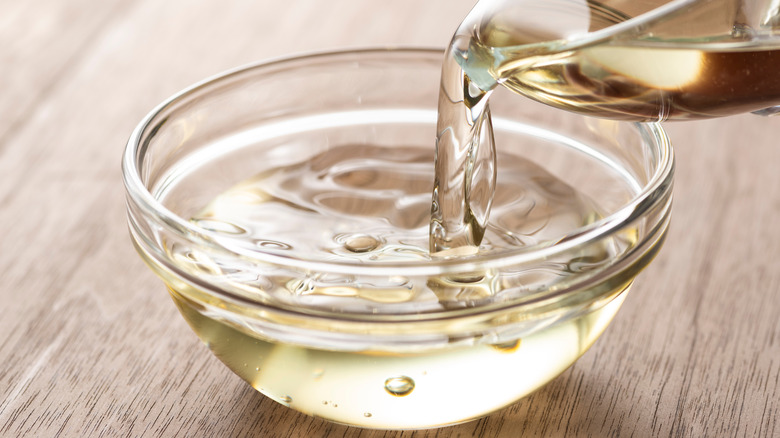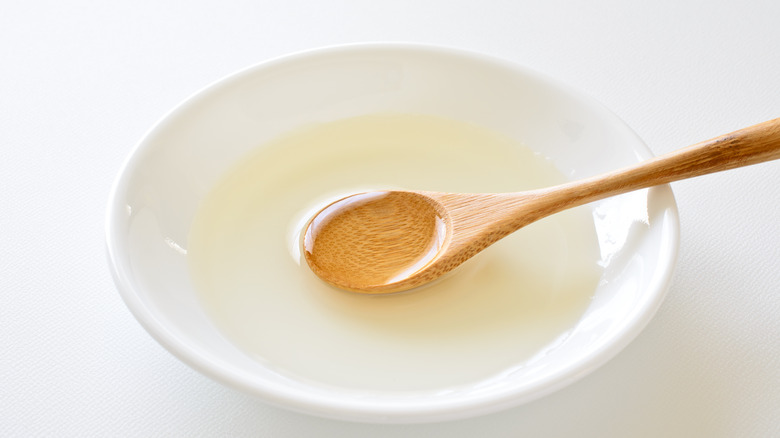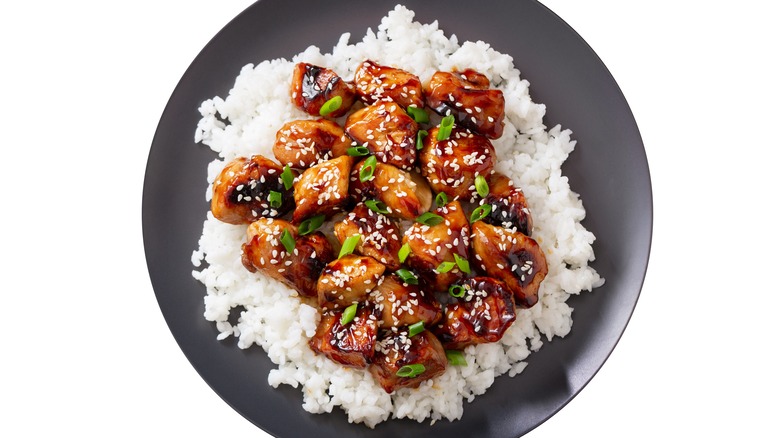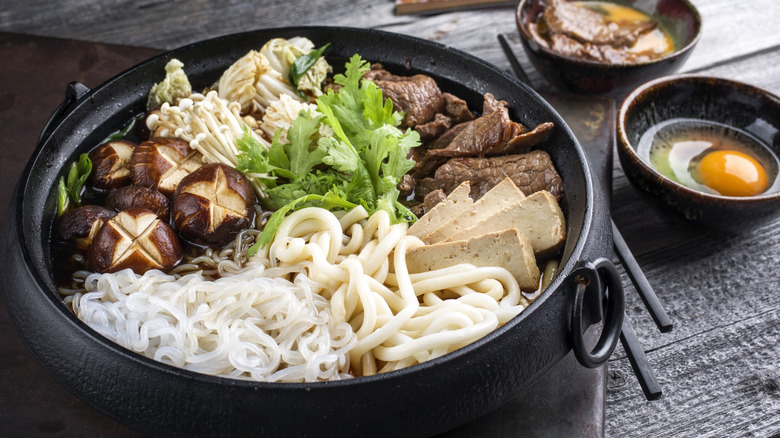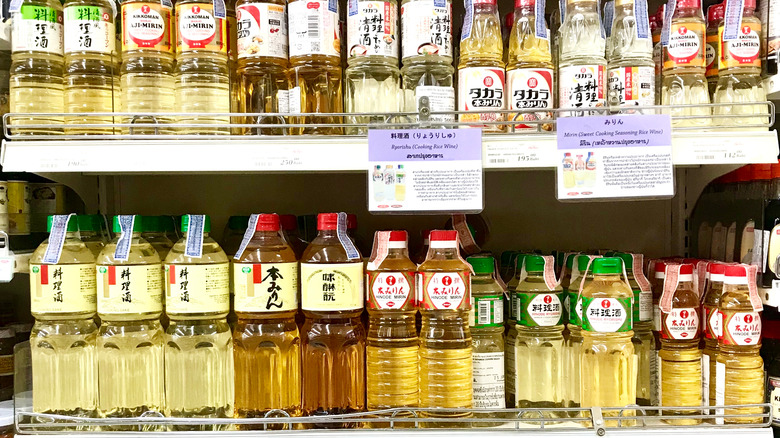What Is Mirin And How Do You Cook With It?
We may receive a commission on purchases made from links.
Mirin was first introduced to Japan between four and six centuries ago, when the sweet fermented rice wine was brought across from China, per Sake Times. Back then it wasn't a condiment, but a beverage that was enjoyed as a tonic to keep heat stroke at bay. Women of the era considered it a healthy beverage (via Oisho So Japan) and used it as a sweetener because sugar was so expensive at the time. Since mirin was often enjoyed straight up as a beverage, people clearly enjoyed the flavor and it didn't take long before it was used to dress up eel and soba dishes.
While mirin has remained popular in Japan since that time, Natural Import Company says it eventually faced two challenges — one was a shortage of rice, which happened during World War II and the other was a post-war liquor tax of 76%, so prices skyrocketed. Mirin became widely used again after a change in tax laws, and now it's used all over the world.
Difference between mirin and sake
While both mirin and sake are made with rice, the way these two products are distilled is what differentiates them, and they have a slightly different flavors.
According to Food Network, in order to make mirin, distillers combine steamed mochi rice and fermented rice (koji). Then they add in sweet potato alcohol (shochu) and it's left to ferment for anywhere from two months to a few years, per Country Living. The fermentation process creates added sugar and leaves brewers with a liquid that is about 14% ABV, which is still quite strong. However, mirin-style seasoning, which is most commonly used in cooking, is made with a different process and only contains 1% ABV (via Sake Times).
While sake is also called rice "wine," Just One Cookbook says the process is more similar to brewing beer. Sake rice grains are milled down until producers are left with just the "heart," which is the starchy interior, per Decanter. That rice is then pounded and steamed before koji is added to the mash to encourage yeast to breed. This process results in a minimum of 15% ABV which can then be filtered and pasteurized. Since sake has a slightly higher ABV, it is less sweet than mirin, so if you need to substitute mirin for sake in recipes, you should mix it with sugar to get the right flavor profile.
What mirin tastes like
Fans of Japanese cooking will recognize mirin for its sweet, yet elusive umami quality found in dishes like grilled yakitori and teriyaki sauce, as well as the soupy sukiyaki. According to Serious Eats, mirin is one of the "indispensable ingredients" in a well-stocked Japanese kitchen. The list also includes other umami-packed ingredients like soy sauce, miso, brown rice vinegar, and seaweed.
If you've used rice wine vinegar before, MasterClass explains that it has a similar flavor profile to mirin, but it also warns that the vinegar will have notes of bitterness and sourness, while mirin just adds sweetness.
How do you cook with mirin?
Using mirin will give your dishes that gentle sweetness and the sugar content will also give meats and sauces a shimmery quality, per Just One Cookbook. Mirin's strength lies in its ability to impart an umami quality to dishes, so it's no surprise that it is so widely used in meat marinades, where it also acts as a tenderizer. It's also an important ingredient in sushi rice, dipping sauces for tempura, or it can be used as a flavor booster for soups and noodle dishes, per MasterClass. According to Japanese Tastes, mirin can even help rid your dish of the smell of raw meat or fish.
If you find yourself without any mirin, Food Network says a mix of three parts sake and one part sugar will work as a substitute, as will rice wine, or dry white wine mixed with sugar. If you have a well-stocked liquor cabinet, you can reach for a bottle of dry sherry, or a sweet marsala wine.
Different variations of mirin
There are three types of mirin in the market today, but "hon mirin," or "true mirin" is the only version that is still made in the classical sense, per Sake Times. Only 1% of mirin sold across the country today falls into this category, and that's because it is made in small lots with all-Japanese ingredients, so it is the most pricey. MasterClass adds that the flavor of this classic version isn't muddled with the addition of sugar or salt.
"Aji mirin" or "mirin-type condiment" is the most commonly known variety of the rice wine. It is classified as synthetic since it is actually made with alcohol, water, and sweeteners to mimic the sugar content that pure mirin achieves with fermentation. Compared to pure mirin, it has a lower ABV of between 1% and 8%.
Another common variety is "mirin fu" which has just less than 1% ABV. It is called a "mirin-like condiment" because it is made with corn syrup, rice seasoning, vinegar, and flavoring and has little to no alcohol.
Hon mirin or true mirin is best kept at room temperature before a bottle is opened, after which it should be kept out of direct sunlight in a tightly sealed bottle for up to three months. Japanese Tastes says mirin-style seasoning can be stored in the refrigerator for the same amount of time.
Mirin nutrition and where to buy it
Because mirin contains alcohol, it isn't exactly light in calories or sugar. But because there are different grades of mirin, the nutritional values can vary somewhat. Two tablespoons of Kikkoman's aji mirin, for example, contain 70 calories, 13 grams of sugar, and 180 mg of salt, which is 8% of your daily value. Meanwhile, two tablespoons of Jun Pacific Hon Miren has 50 calories, 12 grams of sugar, and no added salt. As we mentioned before, the sugar in hon miren is naturally occurring, while aji mirin has added sweeteners. Though these rice wines may be relatively high in sugar, both varieties have 0 grams of fat.
Now that you've read about all the wonderful qualities of mirin, you're probably wondering how you can get your hands on it. Even though mirin contains alcohol, it's technically classified as a condiment, so it can be found in the international aisle of grocery stores or at Asian grocery stores like H Mart (via The Japan Store). You can also buy it online from Amazon or online grocers that specialize in Asian ingredients like Yami.
